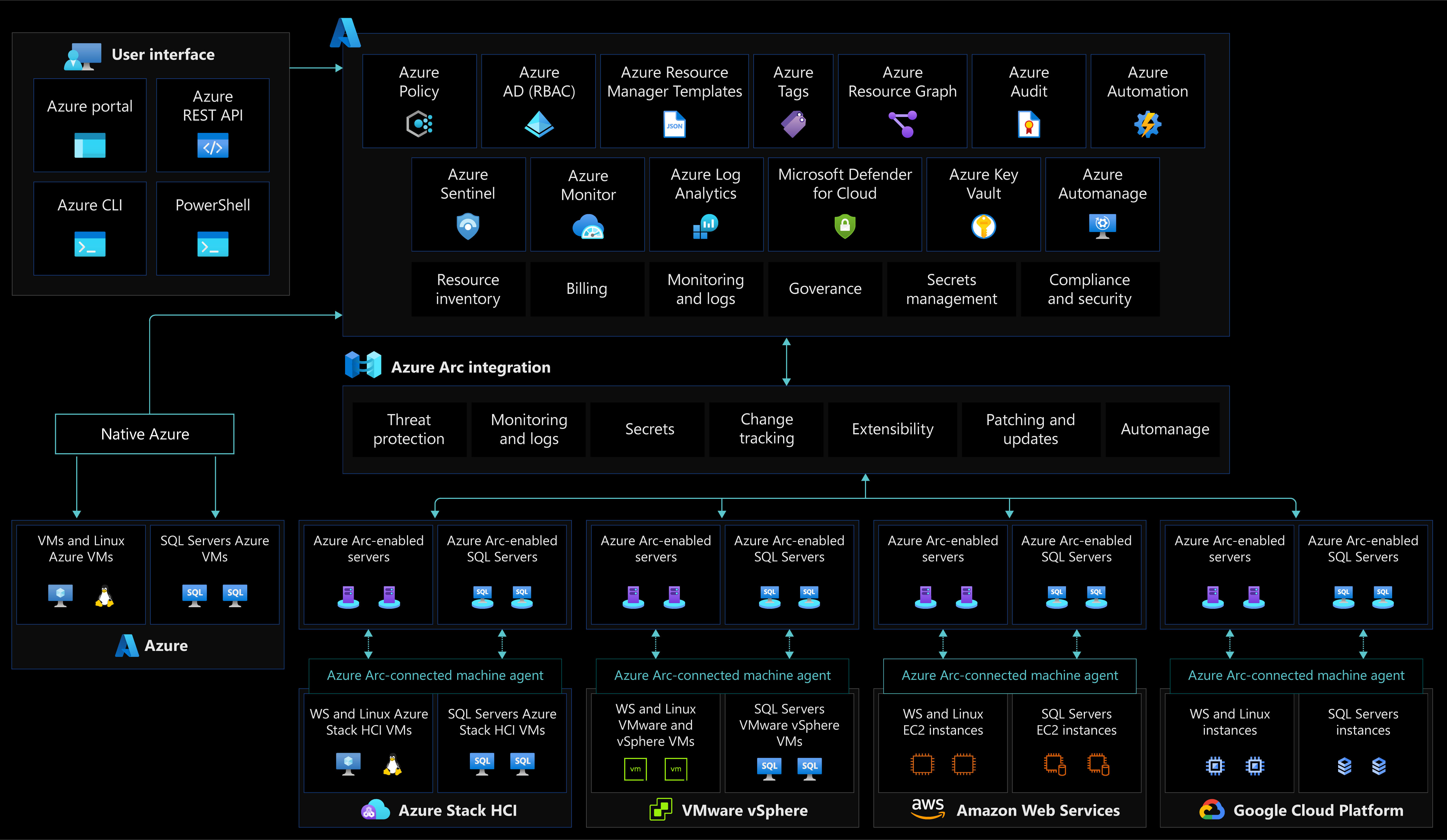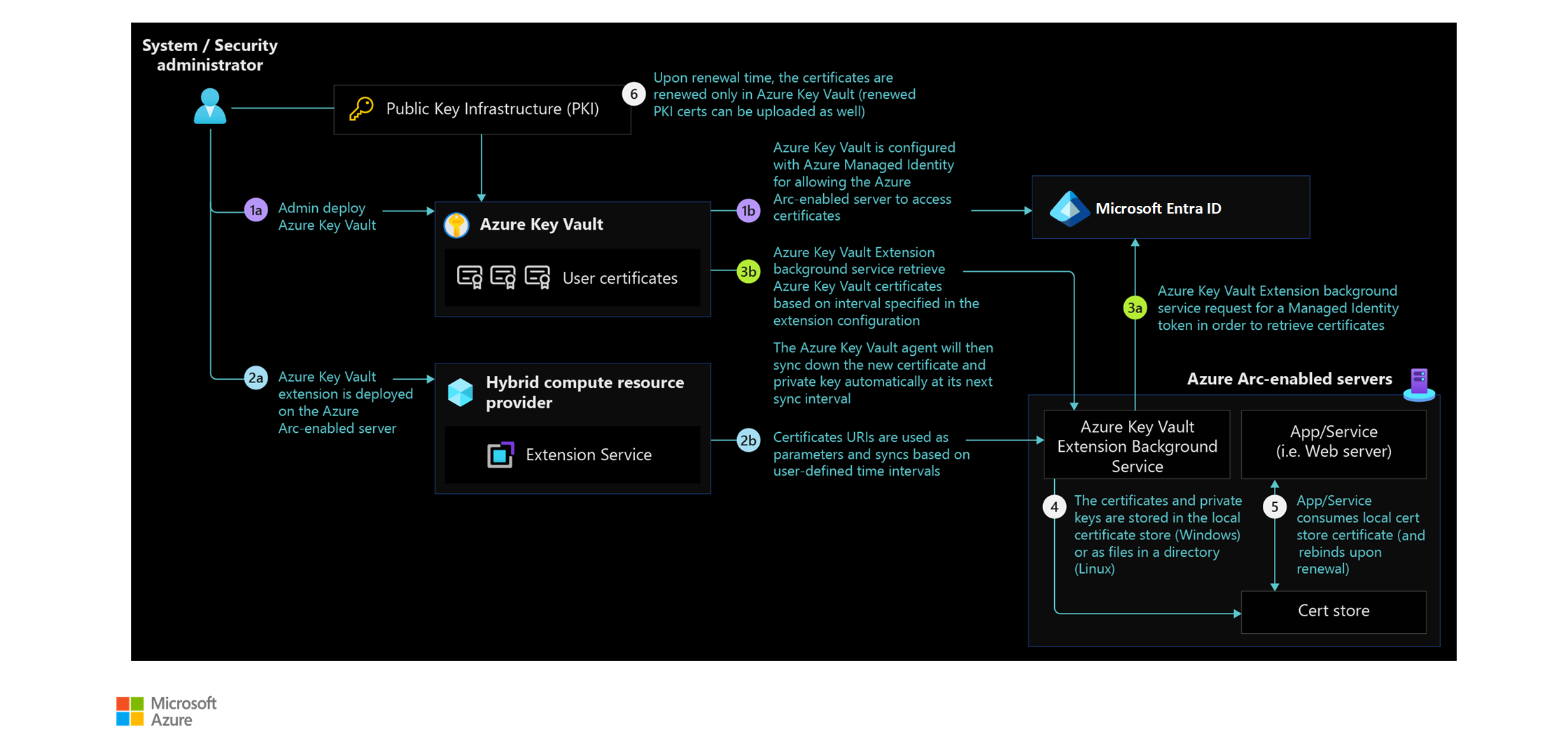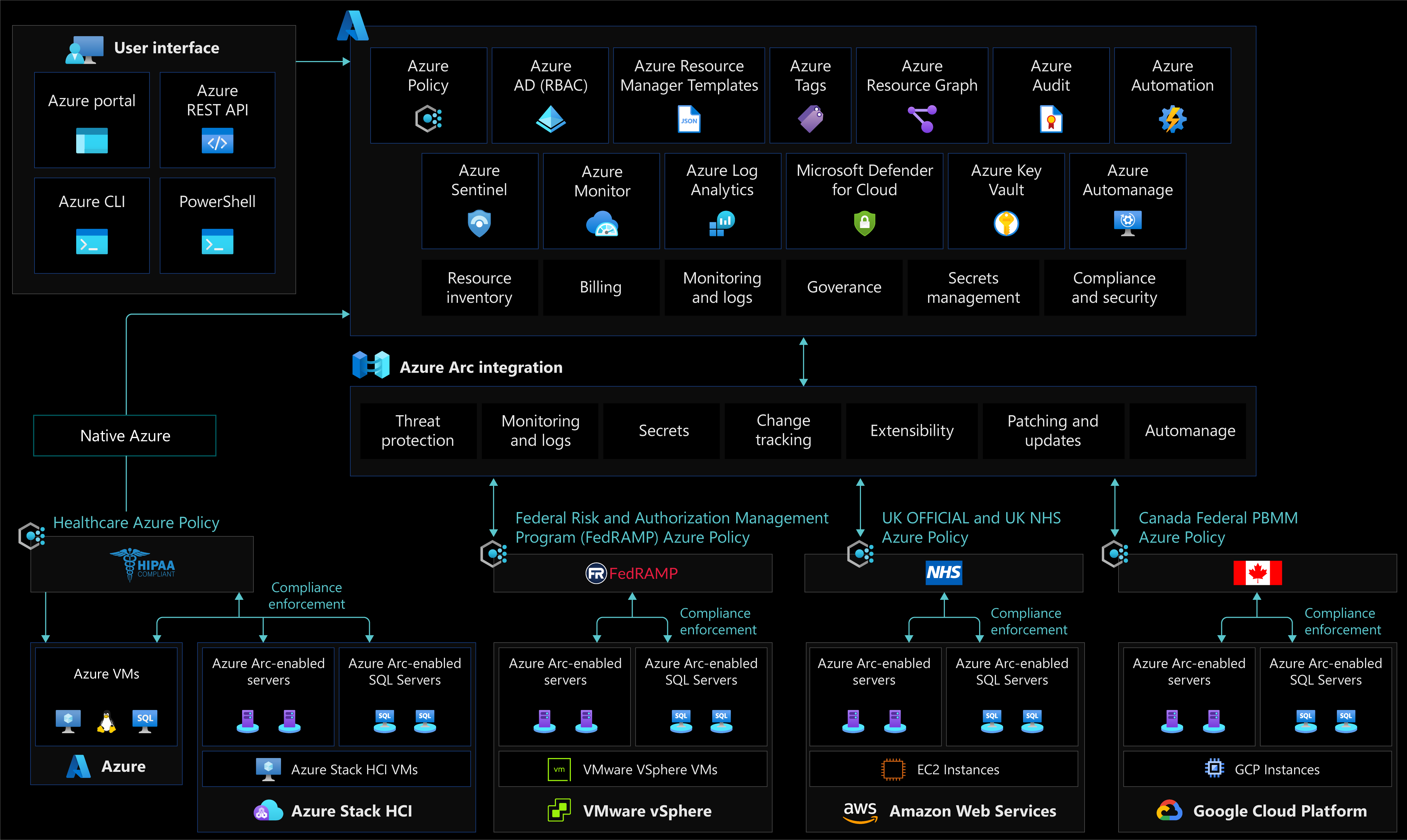Governance, security, and compliance baseline for Azure Arc-enabled servers
This article covers the key design considerations and best practices when implementing security, governance, and compliance for Azure Arc-enabled servers deployments. While the enterprise-scale landing zone documentation covers "Governance" and "Security" as separate topics, for Azure Arc-enabled servers, these critical design areas are consolidated as a single topic.
Defining and applying the proper control mechanisms is key in any cloud implementation, as it's the foundational element to stay secured and compliant. In a traditional environment, these mechanisms usually involve review processes and manual controls. However, the cloud has introduced a new approach to IT governance with automated guardrails and checks. Azure Policy and Microsoft Defender for Cloud are cloud-native tools that allow the implementation of these controls, reports, and remediation tasks in an automated fashion. By combining them with Azure Arc, you can extend your governance policies and security to any resource in public or private clouds.
By the end of this article, you'll understand the critical design areas for security, governance, and compliance with clear Microsoft guidance.
Architecture
The following image displays conceptual reference architecture that demonstrates the security, compliance, and governance design areas for Azure Arc-enabled servers:
Design considerations
As your hybrid and multicloud resources become a part of Azure Resource Manager, they can be managed and governed with Azure tools, just like Azure native VMs.
Identity and access management
- Agent security permissions: Secure access to the Azure connected machine agent by reviewing users with local administrator privileges on the server.
- Managed identity: Use managed identities with Azure Arc-enabled servers. Define a strategy for identifying which applications running on Azure Arc-enabled servers can use a Microsoft Entra token.
- Azure role-based access control (RBAC): Define administrative, operations, and engineering roles within the organization. This will help allocate day-to-day operations in the hybrid environment. Mapping each team to actions and responsibilities will determine Azure RBAC roles and configuration. Consider using a RACI matrix, to support this effort and build controls into the management scope hierarchy you define, while following the resource consistency and inventory management guidance. For more information, review identity and access management for Azure Arc-enabled servers.
Resource organization
- Change Tracking and Inventory: Track changes on the operating system, application files, and registry to identify operational and security issues on your on-premises and other cloud environments.
Governance disciplines
- Threat protection and cloud security posture management: Introduce controls to detect security misconfigurations and track compliance. Also, use Azure's intelligence to protect your hybrid workloads against threats. Enable Microsoft Defender for servers for all subscriptions containing Azure Arc-enabled servers for security baseline monitoring, security posture management, and threat protection.
- Secret and certificate management: Enable Azure Key Vault to protect service principal credentials. Consider using Azure Key Vault for certificate management on your Azure Arc-enabled servers.
- Policy management and reporting: Define a governance plan for your hybrid servers and machines that translates into Azure policies and remediation tasks.
- Data residency: Consider which Azure region you wish your Azure Arc-enabled servers to be provisioned into, and understand the metadata that is collected from these machines.
- Secure public key: Secure the Azure connected machine agent public key authentication to communicate with the Azure service.
- Business continuity and disaster recovery: Review the business continuity and disaster recovery guidance for enterprise-scale landing zones to determine whether your enterprise requirements are met.
- Review the security, governance, and compliance design area of Azure landing zone enterprise-scale, to assess the impact of Azure Arc-enabled servers on your overall security and governance model.
Management disciplines
- Agent management: The Azure connected machine agent plays a critical role in your hybrid operations. It enables you to manage your Windows and Linux machines, hosted outside of Azure, and enforce governance policies. It's important to implement solutions that keep track of unresponsive agents.
- Log management strategy: Plan for metrics and log collection of your hybrid resources into a Log Analytics workspace for further analysis and auditing.
Platform automation
- Agent provisioning: Define a strategy for provisioning the Azure Arc-enabled servers and protecting access to the onboarding credentials. Consider the level and method of automation for bulk enrollment. Consider how to structure pilot and production deployments and establish a formal plan. The scope and plan for a deployment should account for objectives, selection criteria, success criteria, training plans, rollback, and risks.
- Software updates:
- Define a strategy to assess the status of available updates to maintain security compliance, with critical and security updates of your operating systems.
- Define a strategy to inventory the Windows operating system versions and monitor end of support deadlines. For servers that cannot be migrated to Azure or upgraded, plan for Extended Security Updates (ESUs) through Azure Arc.
Design recommendations
Agent provisioning
If using a service principal to provision Azure Arc-enabled servers, consider how to securely store and distribute the service principal password.
Agent management
The Azure connected machine agent is the key piece for Azure Arc-enabled servers. It contains several logical components that play a role in security, governance, and management operations. If the Azure connected machine agent stops sending heartbeats to Azure, or goes offline, you will not be able to perform operational tasks on it. Hence, it's necessary to develop a plan for notifications and responses.
Azure activity log can be used to set up resource health notifications. Remain informed on the current and historical health status of the Azure connected machine agent by implementing a query.
Agent security permissions
Control who has access to the Azure connected machine agent on Azure Arc-enabled servers. The services that compose this agent control all communication and interaction for the Azure Arc-enabled servers to Azure. Members of the local administrator group on Windows and users with root privileges on Linux have permissions to manage the agent.
Evaluate restricting the extensions and machine configuration capabilities with local agent security controls to permit only necessary management actions, especially for locked-down or sensitive machines.
Managed identity
At creation, the Microsoft Entra system-assigned identity can only be used to update the status of the Azure Arc-enabled servers (for example, the 'last seen' heartbeat). In granting this system-assigned identity additional access to Azure resources, it becomes possible to allow an application on your server to use the system-assigned identity to access Azure resources (for example, to request secrets from a Key Vault). You should:
- Consider which legitimate use-cases exist for server applications to obtain access tokens and access Azure resources, while also planning for access control of these resources.
- Control privileged user roles on Azure Arc-enabled servers (members of the local administrators or Hybrid Agent Extensions Applications group on Windows and members of the himds group on Linux) to avoid system-managed identities being misused to gain unauthorized access to Azure resources.
- Use Azure RBAC to control and manage the permission for Azure Arc-enabled servers managed identities and perform periodic access reviews for these identities.
Secret and certificate management
Consider using Azure Key Vault to manage certificates on your Azure Arc-enabled servers. Azure Arc-enabled servers have managed identity, which is used by the connected machine and other Azure agents to authenticate back to their respective services. The key vault VM extension allows you to manage the certificate lifecycle on Windows and Linux machines.
The following image displays conceptual reference architecture that demonstrates the Azure Key Vault integration for Azure Arc-enabled servers:
Tip
Learn how to use Key Vault managed certificates with Azure Arc-enabled Linux servers in the Azure Arc Jumpstart project.
Policy management and reporting
Policy-driven governance is a foundational principle of cloud-native operations and the Cloud Adoption Framework. Azure Policy provides the mechanism to enforce corporate standards and to assess compliance at-scale. You can implement governance for consistency of deployments, compliance, control costs, and improve your security posture. With its compliance dashboard, you will get an aggregated view of the overall state, and remediation capabilities.
Azure Arc-enabled servers support Azure Policy at the Azure resource management layer, and also within the machine operating system using machine configuration policies.
Understand the scope of Azure Policy and where it can be applied (management group, subscription, resource group, or individual resource level). Create a management group design in accordance with the recommended practices outlined in the Cloud Adoption Framework enterprise-scale
- Determine what Azure policies are required by defining business, regulatory, and security requirements for Azure Arc-enabled servers.
- Enforce tagging and implement remediation tasks.
- Understand and evaluate the Azure Policy built-in definitions for Azure Arc-enabled servers.
- Understand and evaluate the built-in machine configuration policies and initiatives.
- Evaluate the need for creating custom machine configuration policies.
- Define a monitoring and alerting policy that identifies unhealthy Azure Arc-enabled servers.
- Enable Azure Advisor alerts to identify Azure Arc-enabled servers with outdated agents installed.
- Enforce organization standards and assess compliance at-scale.
- Use Azure Policy and remediation tasks to onboard management service agents via the extension management feature.
- Enable Azure Monitor for compliance and operational monitoring of Azure Arc-enabled servers.
The following image displays conceptual reference architecture that demonstrates the policy and compliance reporting design areas for Azure Arc-enabled servers:
Log management strategy
Design and plan your Log Analytics workspace deployment. It will be the container where data is collected, aggregated, and later analyzed. A Log Analytics workspace represents a geographical location of your data, data isolation, and scope for configurations like data retention. You'll have to identify the number of workspaces needed and how it maps to your organizational structure. It's recommended you use a single Azure Monitor Log Analytics workspace to manage RBAC centrally, for visibility, and reporting, as described in the management and monitoring best practices of Cloud Adoption Framework.
Review the best practices in Designing your Azure Monitor Logs deployment.
Threat protection and cloud security posture management
Microsoft Defender for Cloud provides a unified security-management platform segmented as a cloud security posture management (CSPM) and cloud workload protection platform (CWPP). To increase security on your hybrid landing zone, it's important to protect the data and assets hosted in Azure and elsewhere. Microsoft Defender for servers extend these capabilities to Azure Arc-enabled servers and Microsoft Defender for Endpoint provides endpoint detection and response (EDR). To strengthen the security of your hybrid landing zone, consider the following:
- Use Azure Arc-enabled servers to onboard hybrid resources in Microsoft Defender for Cloud.
- Implement an Azure Policy machine configuration to make sure all resources are compliant and its security data is collected into the Log Analytics workspaces.
- Enable Microsoft Defender for all subscriptions and use Azure Policy to ensure compliance.
- Use security information and event management integration with Microsoft Defender for Cloud and Microsoft Sentinel.
- Protect your endpoints with Microsoft Defender for Cloud's integration with Microsoft Defender for Endpoint.
- For securing the connectivity between Azure Arc-enabled servers and Azure, review the Network connectivity for Azure Arc-enabled servers section of this guide.
Change Tracking and Inventory
Centralizing logs drives reports that can be used as additional layers of security and reduces the chances for gaps in observability. Change Tracking and Inventory in Azure Automation forward and collects the data in a Log Analytics workspace. When using Microsoft Defender for servers, you get File Integrity Monitoring (FIM) to examine and track software changes, for Windows services and Linux daemons on your Azure Arc-enabled servers.
Software updates
With Azure Arc-enabled servers, you can manage your enterprise estate with centralized management and monitoring at-scale. More specifically, it provides alerts and recommendations to IT teams, with full operational visibility that includes managing the updates of your Windows and Linux VMs.
Assessing and updating your operating systems should be a part of your overall management strategy, to maintain security compliance with critical and security updates as they are released. Use Azure Update Manager as a long-term patching mechanism for both Azure and hybrid resources. Use Azure Policy to ensure and enforce the maintenance configurations of all VMs, including your Azure Arc-enabled servers and Extended Security Updates (ESUs) deployment to Azure Arc-enabled servers that have Windows versions that have reached end of support. For more information, see Azure Update Manager overview.
Role-based access control (RBAC)
Following the least privilege principle, users, groups, or applications assigned with roles like "contributor" or "owner" or "Azure Connected Machine Resource Administrator" are able to execute operations like deploying extensions, which basically has root access on Azure Arc-enabled servers. These roles should be used with caution, to limit the possible blast radius or eventually replaced by custom roles.
To limit the privilege of a user and only allow them to onboard servers to Azure, the Azure Connected Machine Onboarding role is suitable. This role can only be used to onboard servers and cannot re-onboard or delete the server resource. Make sure to review the Azure Arc-enabled servers security overview for more information about access controls.
Review the Identity and access management for Azure Arc-enabled servers section of this guide for more identity and access related content.
Also consider the sensitive data that is sent to the Azure Monitor Log Analytics workspace, the same RBAC principle should be applied to the data itself. Azure Arc-enabled servers provide RBAC access to log data collected by the Log Analytics agent, stored in the Log Analytics workspace the machine is registered to. Review how to implement granular Log Analytics workspace access in the designing your Azure Monitor Logs deployment documentation.
Secure public key
The Azure connected machine agent uses public key authentication to communicate with the Azure service. After you onboard a server to Azure Arc, a private key is saved to the disk and used whenever the agent communicates with Azure.
If stolen, the private key can be used on another server to communicate with the service and act as if it were the original server. This includes getting access to the system-assigned identity and any resources that identity has access to.
The private key file is protected to only allow the Hybrid Instance Metadata Service (himds) account access to read it. To prevent offline attacks, we strongly recommend the use of full disk encryption (for example, BitLocker, dm-crypt, and so on). On the operating system volume of your server. We recommend using Azure Policy machine configuration to audit Windows or Linux machines that have the specified applications installed, such as the ones mentioned.
Next steps
For more guidance for your hybrid cloud adoption journey, review the following:
- Review Azure Arc Jumpstart scenarios
- Review the prerequisites for Azure Arc-enabled servers
- Plan an at-scale deployment of Azure Arc-enable servers
- Understand how to manage hybrid and multicloud environments
- Learn more about Azure Arc via the Azure Arc learning path.
Feedback
Coming soon: Throughout 2024 we will be phasing out GitHub Issues as the feedback mechanism for content and replacing it with a new feedback system. For more information see: https://aka.ms/ContentUserFeedback.
Submit and view feedback for


